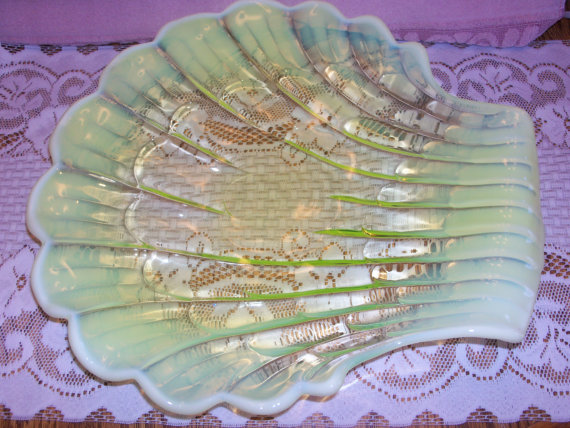I was cruising through one of my favorite thrift stores on Friday; work had ended and I was taking a poke through this little haven. I’d gathered a few things which were sliding around in my basket when I spotted this little goody.

It wasn’t much to look at when I found it. The top was all tarnished and spotted. The glass was dirty. I wish I had taken a picture before I cleaned it so you could all see, but I was eager to see the treasure hiding behind the tarnish. Even my daughter said “Wow!” when she saw the cleaned-up version. It is a pretty little piece. I recognized the pattern of this butter dish as a Duncan-Miller piece. I know because I have this other piece shown below that I found a few weeks ago. My daughter says the pattern above reminds her of little feet – that’s what I thought, too! Like little toes.

So who was Duncan or, for that matter, Miller? Well, according to the National Duncan Glass Society, the beginning of what was to become Duncan-Miller happened when George Duncan bought a glass factory formerly owned by Ripley & Company of Pittsburgh, Pennsylvania. There was some association between Duncan and Ripley but they did not go into business together.

There is a connection to Duncan Glass and Heisey Glass, though, as Duncan’s daughter, Susan, was married to Augustus H. Heisey (check out my post on Heisey Glass “Hooray for Heisey“). It’s definitely a small world! So, originally Duncan formed his company with his 2 sons James and Harry and his son-in-law, Augustus. They were originally named George Duncan & Sons. They were located near the Monongahela River giving them easy access to glass-making resources by barge.

In 1874 John Ernest Miller was persuaded to join the company. He had over 20 years experience manufacturing glass already. The National Duncan Glass Society states that Miller was hired as a designer for Duncan’s company. He eventually became “internationally famous for his designs of Duncan and Miller Glass during the next fifty-two years” (National Duncan Glass Society).

As time went on Augustus left to start his own glass business. Then the Duncan & Sons factory burned down, which seemed a common occurrence back then if you read some of my other posts! George Duncan died in 1877 so his son James took over. The factory was moved to Washington, Pennsylvania where natural gas for the furnaces was easy to get and cheap. They were also close to railroads there, which replaced the river for ease of getting the glass-making resources to the factory fast and inexpensively.

Late in the year 1900, the structure of the company was changed to include Miller. That time was known as the “Duncan-Miller period” (National Duncan Glass Society). In a time when there was plenty of glass being produced, they were known for their great designs, workmanship and colors. They produced many patterns and designs for the next fifty years.

Unfortunately, they fell prey to the machine age. It was not as economical to make fine hand-made glass as it was to mass produce it with machines. When they closed, the National Duncan Glass Society says that people came from hundreds of miles to buy up the last pieces of Duncan-Miller glass at clearance prices. The plant closed in 1955 and the building was destroyed by fire on June 29, 1956.

Some of the patterns that were well-known are: Diamond Ridge, Block & Rosette, Ladder with Diamonds, Colonial, Thumbprint Block Band, Clover, Homestead, Sunburst in Oval, and King Arthur (Patternglass.com). So know that any Duncan-Miller glass you own was produced before 1956.

I hope you have enjoyed this look at Duncan-Miller! There are so many great companies that we have just touched on at Vintage Eve’s with so many more to explore. I’m looking forward to sharing lots more with you.
If you have a chance, leave me a message! I love to hear from my readers.
I am partying this week at:
Follow my blog with Bloglovin!

